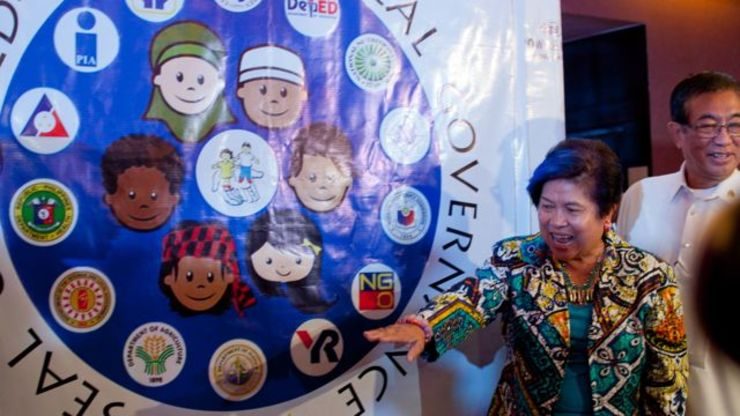SUMMARY
This is AI generated summarization, which may have errors. For context, always refer to the full article.

MANILA, Philippines – If your local government provides free health care, keeps children in school, and works with families and civil society, chances are it’s a child-friendly city or municipality.
The year 2014 marks the 25th year since countries around the world committed to protect children’s rights by ratifying the Convention on the Rights of the Child (CRC).
The Philippines is the 31st state to ratify the Convention. To signify its commitment to protect children’s welfare, government officials on Wednesday, October 8, launched a series of strategies that would help achieve the vision of a child-friendly Philippines.
Key to this strategy is the efficient delivery of local government services and programs that would benefit children.
LGUs will be subjected to a mandatory audit to assess their performance, and earn them the seal of being a child-friendly city or municipality.
Starting at the local level
While the Convention emphasized the state’s responsibility in promoting children’s welfare, LGUs are vital to make the initiative work, said Lotta Sylwander, country representative of UNICEF.
Sylwander said the UN agency is working with LGUs to computerize the audit process and identify an ideal plan of action.
“In a country where the mayor is king, UNICEF is supporting the audit and is computerizing the audit process in rating cities and municipalities based on important criteria and indicators,” Sylwander said.
These indicators include the number of children who attend school, how LGUs ensure the safety of children, and the local units’ delivery of health services.
Sylwander said it is important to identify and address the gaps in the system.
“What cannot be measured cannot be managed. So if you know what you have, it’s easier to plan, to act, to react, to look forward,” she added.
Social Welfare Secretary Corazon Soliman said the vision of a child-friendly Philippines cannot be wholly achieved without the active cooperation of barangays and local units.
Soliman added that local officials are in the best position to identify and weed out possible perpetrators against children.
“Ang mga taga-barangay, ang mga mayor, ang mga pulis doon mismo sa mga barangay at bayan ang nakakakilala ng drug pusher, ng sindikato, ng hindi taga-roon na mag-ta-traffic ng mga bata, na nagsusuporta ng prostitution dens,” Soliman said.
(Those from the barangay, the mayors, the police – they are the ones who know who the drug pushers and syndicates are, the non-residents who engage in child trafficking and support prostitution dens.)
She added, “If barangays are not active in the protection of children, we will not have a true child-friendly Philippines.”
Conducting the audit
How does a city earn a child-friendly stamp of approval?
In July, the Department of the Interior and Local Government (DILG) issued a memorandum ordering an audit to measure the performance of LGUs in delivering social services for children.
Auditors will check if the LGU implements programs that satisfy 12 indicators on health and nutrition, education, protection, and child participation.
To assess if a city or municipality is child-friendly, auditors check the LGU’s programs against the following criteria:
- In health: the percentage decrease in the deaths of children below 5 years old; the number of children with below normal weight; 2013 PhilHealth accreditation in the LGU’s main health facility for Maternal Care Services and Primary Care
- In education: the percentage increase in the number of 3 to 4-year-olds attending center-based day care services; the number of children who complete elementary school; a Local School Board (LSB) Plan, with at least 70% completion for 2013
- In protection: the absence or decrease in child labor cases; safety measures in communities and schools; a decrease in the number of child victims of violence, abuse, neglect and exploitation; the creation of an ordinance establishing Barangay Violence Against Women and their Children (VAW/C) desks
- In children’s participation: the extent of involving children’s rights in the LGU’s core development agenda
The launch of the Child-Friendly Philippines program on Wednesday also highlighted the achievements of 3 model LGUs that had won presidential awards for their child-friendly initiatives.
Mandaluyong City, for instance, boasts of having one of the lowest school drop-out rates in the Philippines, and a decrease in the number of juvenile crimes. The city also has its own education project for young mothers and children with special needs.
Tagaytay City offers free hospitalization and college education to residents, and has a maternal and child care program. The city also encourages children to read books in its “Drop Everything and Read Initiative.”
The municipality of Villaverde, Nueva Vizcaya, reported a decrease in the number of dropouts – a feat it ascribes to the government’s conditional cash transfer program. The municipality also touts having a 0% infant and maternal mortality rate.
LGUs that pass the Child-Friendly Local Governance Audit will then be conferred with the Seal of Child-Friendly Local Governance by the CWC.
Those awarded with the seal are qualified for an incentive and award system under the Presidential Award for Child-Friendly Municipalities and Cities.
Patricia Luna, officer-in-charge-Executive Director of the CWC, said that of the 1,367 cities and municipalities audited, 69.71% or 953 are eligible for the conferment of the seal. – Rappler.com
Add a comment
How does this make you feel?
There are no comments yet. Add your comment to start the conversation.